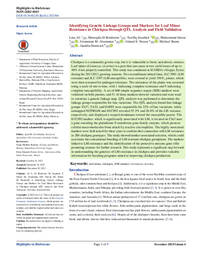Identifying Genetic Linkage Groups and Markers for Leaf Miner Resistance in Chickpea through QTL Analysis and Field Validation

Authors:
Chickpea is a commonly grown crop, but it is vulnerable to biotic and abiotic stresses. Leaf miner (Liriomyza cicerina) is a pest that can cause severe yield losses of up to 40% if not properly controlled. This study was conducted at ICARDA (Aleppo, Syria) during the 20112012 growing seasons. Two recombinant inbred lines, ILC 5901 (LM resistant) and ILC 3397 (LM susceptible), were crossed to yield 350 F2 plants, which were then screened for pathogen tolerance. The resistance of the plants was screened using a scale of one to nine, with 1 indicating complete resistance and 9 indicating complete susceptibility. A set of 600 simple sequence repeat (SSR) markers were validated on both parents, and 51 of these markers showed variation and were used to construct a genetic linkage map. QTL analysis was performed to determine the linkage groups responsible for line variations. The QTL analysis found that linkage groups TA37, TA34, and H4F03 were responsible for 22% of line variations, while unmapped NCPRG48 and H1C092 revealed 55.3% and 26.8% of the LIS variance, respectively, and displayed a warped dominance toward the susceptible parent. The H1C092 marker, which is significantly associated with LM, is located on Chr3 near a gene encoding the glutathione S-transferase gene family enzyme, which protects cellular macromolecules from attack by reactive electrophiles. The highly associated markers were field tested for three years to confirm their connection with LM resistance in 200 chickpea genotypes. The study showed marker-associated selection, which could accelerate the conventional breeding of LM-resistant chickpea germplasm. The markers linked to LM resistance and the identification of the protective enzyme gene o er promising avenues for further research. This study represents a significant step forward in understanding the genetics of LM resistance in chickpea and provides valuable information for breeding programs aimed at improving chickpea production.
